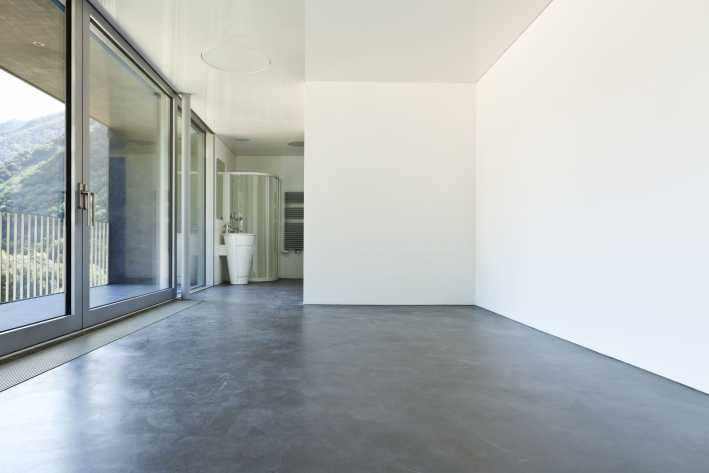
Laminate flooring installation: Costs and advantages
When it comes to house renovation, only focusing on lighting and furniture is a huge mistake. Flo...
Concrete slabs have long been used as a reliable flooring material for warehouses, patios, garages, and retail establishments. Nevertheless, in the modern world, concrete floors went far beyond utility surfaces, becoming a great addition to home interiors. They are polished, stained, and etched to serve as the finished flooring surface. Though concrete floors are not made to fit every home, they can easily become an elegant eye-catcher on the premises if they are selected and installed the right way. This in-depth concrete flooring installation guide was made to help you learn the basics of this flooring type. It features the advantages and downsides of concrete floors, their installation and maintenance requirements, and tips on switching from standard flooring to concrete. Keep reading to decide whether concrete is a suitable flooring type for your home.

Concrete is one of the most durable and robust flooring materials that does not require special maintenance and can preserve its initial look for as long as you own your premises. Thanks to the diverse design options, concrete floors are distinguished by their eye-popping aesthetics and unexpected style. Nevertheless, concrete is a hard material that can be felt uncomfortable and cold underfoot, especially in cold climates. It is also pretty heavy and fits only those building constructions with concrete or slab-on-grade foundations.

Due to their special characteristics, concrete floors cannot suit every room in the house. They are cold, so you will hardly want to see them in the bedroom or children's room. Nevertheless, in the areas where high moisture resistance and durability matter most, concrete floors are indispensable. See below to find the rooms where you can get the most out of installing concrete floors:
There are a few types of concrete floors available on the market. They vary by their appearance, properties, and cost per square foot. That is why knowing the difference between them is essential to invest your flooring budget wisely.
Concrete floors are relatively easy to upkeep, especially compared to other popular flooring options like carpeting and solid wood. When properly sealed, they are not vulnerable to stains and moisture. Besides, they are extremely difficult to damage or scratch. That is why you won't need to refinish them often. Depending on the level of traffic, sealing and waxing are required once in three to five years. Besides, concrete floors should be vacuumed and cleaned using a damp mop weekly. If you don't need to deal with stubborn stains, it is recommended to use neutral cleaning agents for concrete floors.
Concrete cracking is one of the few common problems when the structural slab has adapted to a finished residential flooring surface. The solution to it might be patching and refinishing or complete resurfacing. If you have to deal with stains absorbed into the concrete flooring surface, consider applying a tinted sealer or a new coat of concrete stain or dye.
Like any other flooring option, concrete has its own advantages and downsides that are worth evaluating to determine whether this option is worth the investment. Here are the key pros that make concrete an attractive offer for durable flooring coverages for commercial and residential use.
Here are the cons of concrete flooring that are a must to consider to get the best fit for your needs and budget:
Concrete is a mid-priced flooring material that tends to be more expensive than vinyl and carpet yet less costly than hardwood and stone. It's considered cost-effective as it offers a long service life requiring a humble initial investment. Nevertheless, the cost of concrete flooring varies depending on its finish. The high-end custom floors made of concrete can cost as much as $30 per square foot for the material only, while those with a basic design that involves polishing and dyeing will cost you $6 per square foot at max. Stained concrete typically costs $7 to $15 per square foot, while a polished one costs $6 to $12.
Concrete flooring installation costs vary from $3 to $7 per square foot but can go even higher if the installer has to deal with staining, sealing, and polishing the new concrete floors. Besides, services like adding underlayment or repairing a floor surface will be estimated additionally. You should expect to pay around $2 - $3.50 per square foot for repair services made with concrete floors. Adding stains to concrete costs $6 per square foot, while grinding can cost between $1 and $4 per square foot.
If you want to discover the cost of concrete floors per square foot relevant to your project, answer a couple of questions in our request form. Once we get your data. We will be able to provide you with a clear-cut estimate from concrete flooring installers operating in your region.
GET THE ESSENCE OF RELEVANT HOME
IMPROVEMENT TOPICS IN LESS THAN 5 MINUTES

When it comes to house renovation, only focusing on lighting and furniture is a huge mistake. Flo...

Stone is the number one flooring choice for homeowners seeking to enhance their property's value....

Stay tuned!